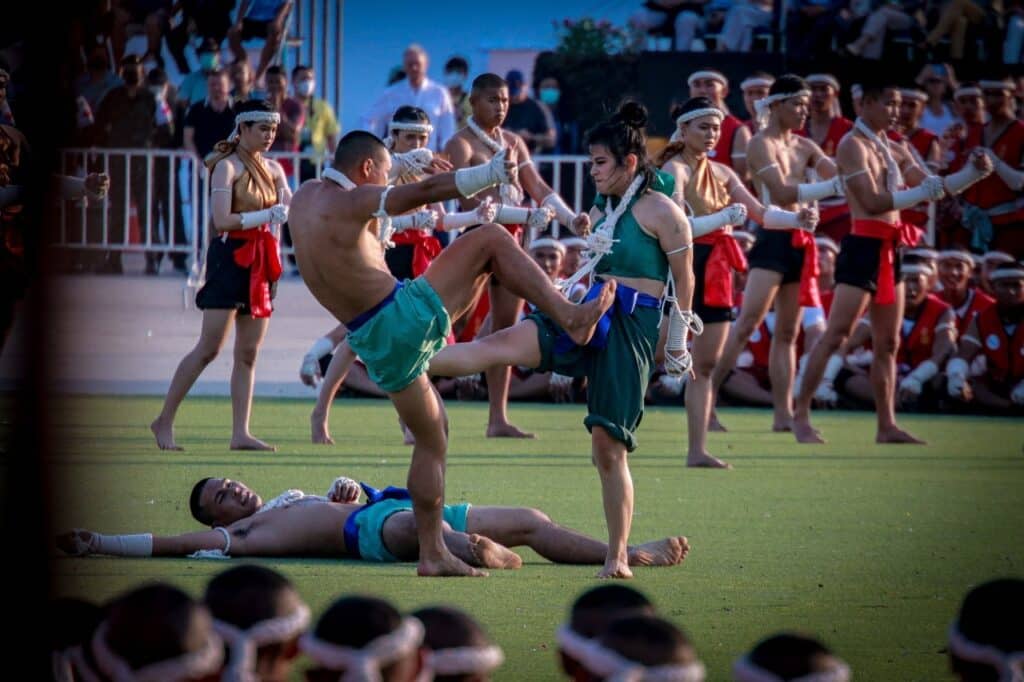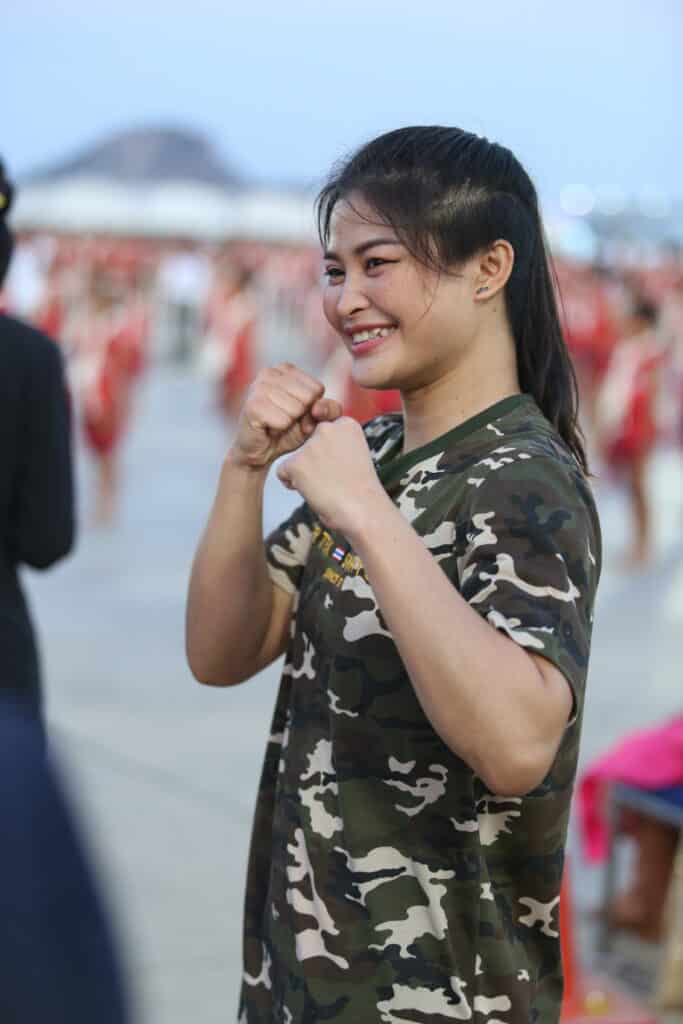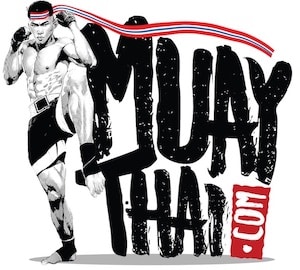Muay Thai Basics: Art Of 8 Limbs Explained
What are the Muay Thai basics that every viewer or athlete must know? Muay Thai can be labeled either a combat sport or a martial art. It is a fighting system which is the national sport of Thailand. It is known as the ‘Art of Eight Limbs’ because a fighter can use punches, kicks, knees, and elbows in combat.
Muay Thai dates back hundreds of years in Thailand and even has traditions from Thai Buddhism woven into the sport. All people in Thailand would have some form of training in Muay Thai; from boys and girls to kings and queens, of all classes.
Below are the Muay Thai basics that everyone who wants to know the sport must understand. It is a large overview which covers, terminology, history and tradition, championship titles, Muay Thai basics of fighting, and people to know.

Terminology – Words that cover Muay Thai basics
There are some Muay Thai basics of terminology that one should know as it will make it easier to learn Muay Thai at a basic or advanced level.
| Muay Thai: | Thai Boxing |
| Nak Muay: | Muay Thai Fighter |
| Kru: | Muay Thai Master/Instructor |
| Farang: | Foreigner of Western (European/American) Descent |
| Wai Khru Ram Muay: | Traditional Dance |
| Muay Mat: | A fighter who is focused on punch attacks. For example Rodtang Jitmuangnon |
| Muay Tae: | A fighter who is focused on kick attacks. For example Buakaw Banchamek |
| Muay Khao: | A fighter who is focused on knee attacks. For example Dieselnoi Chor Thanasukarn |
| Muay Sok: | A fighter who is focused on elbow attacks. For example Nathan Corbett |
| Muay Femur: | A fighter who is focused on being a technician, strong overall. For example: Nong-O Gaiyanghadao and Samart Payakaroon. |
| Mongkon: | Traditional headgear worn by Nak Muay |
| Pra Jiad: | Traditional armband worn by Nak Muay. |
History and Tradition
While the name had not yet been invented, Muay Thai can trace its roots back to the 16th century and begins as a martial art taught by the military. No boxing gloves were used at the time, and matches were bare knuckle but the tactics were utilized in actual warfare. The techniques and Muay Thai basics that were taught would be used with a pike, spear, or sword.
Over time, Muay Thai developed away from being a martial form of war and into a sport. Bare knuckle fights would fall out of style as fighters would eventually adopt horse leather or rope to wear across their knuckles. Only in the 20th century did boxing gloves become normal. Wearing boxing gloves is certainly to be a part of Muay Thai basics.
The sport is steeped in spiritual traditions as fights used to be held primarily at Thai Buddhist temples. At the start of each match, the two nak muay athletes will perform a Wai Khru Ram Muay which is a traditional dance.
Each athlete will also be wearing Mongkon and Pra Jiad. Mongkon is the headband worn by fighters and is given by the trainer to a student to signify aptitude. Pra Jiad are the traditional armbands worn by athletes. It is typically made by a close family member and meant to bring good luck to an athlete. It is a pillar of the sport and considered part of Muay Thai basics.
A typical Muay Thai fighter today will have begun their professional career as a child somewhere between the ages of eight and fourteen. Nak Muays typically compete frequently, nearly weekly, so a career can often be short-lived. Many Nak Muays will have a decorated and full career by the time they are 25. This is also why so many fighters will have hundreds of bouts throughout their active years.
Traditionally, Muay Thai music is played during matches with a live band. Drums and pipes will be played throughout fights, and the music gets faster as the action accelerates. Experts of Muay Thai basics will often flood the arena to bet on matches. Gambling is a large cornerstone of Muay Thai.
For naming a fighter, Nak Muays are typically assigned a nickname that they will use for their entire fight career, followed by the gym they train at. For example, Dieselnoi Chor Thanasukarn was born Thanakorn Sorndee but was given the name ‘Dieselnoi’ which means little diesel, and he trained at the Chor Thanasukarn gym. Thus, he uses the name “Dieselnoi Chor Thanasukarn.” Naming conventions for Farang do not follow the conventional Muay Thai basics, instead, they use their birth name.

Championship Titles
Today it seems like every MMA fighter or Kickboxer has a world title in Muay Thai. Only a few world championship titles carry any true significance though. In order of highest value, the most important world titles in Muay Thai are Rajadamnern Stadium and Lumpinee Stadium.
When people discuss the golden age of Muay Thai, they’re talking about the fighters who fought through the legendary Rajadamnern and Lumpinee Stadiums. Both of these date back to the mid 19th century.
While Rajadamnern and Lumpinee are the paramount crowns, there are other valuable titles a fighter can earn in Muay Thai. For example, Omnoi Stadium, ONE Championship, Channel 7 Championship, True4U Muaymunwunsuk, and WBC Muay Thai, are all valuable in their own right.

Muay Thai Basics of Fighting
After the Wai Khru Ram Muay is performed, and the Mongkhon & Pra Jiad are removed, the most important aspect of Muay Thai can begin: the fighting. The Muay Thai basics listed here will cover a large overview of matches.
Muay Thai fights are contested in a four-sided ring while wearing gloves and shorts. Matches are normally three or five rounds at three minutes each. Fighters are split up into weight classes, as one would find in boxing, kickboxing, or MMA.
Fighters are allowed to use punches, kicks, knees, elbows, and clinching, to defeat their opponent. Matches can be won by a judge’s decision, knockout, or technical knockout (TKO). A TKO is when the referee will step in to stop the match if the official deems a fighter unable to continue.
Punching in Muay Thai is similar to that of boxing. Fighters can use a jab, crosses, hooks, overhands, and uppercuts, to target their opponent’s head or abdomen. Unlike in Western Boxing, Nak Muays are permitted to utilize backhand and superman punches.
There are various elbow strikes a Nak Muay can use such as the horizontal elbow, slash, forward thrust, spinning elbow, and others. Elbows are not allowed in traditional Kickboxing, making Muay Thai a unique combat sport.
With a kick strike, a fighter may target their opponent’s head, abdomen, thigh, or calf. The most common types of kicks used are the teep kick and roundhouse kick. Teep kick is a forward thrust of one’s foot in a direct motion. A roundhouse kick is when a fighter turns their hips over swinging their leg in an arc and strikes their opponent with their shin. Each of those two kicks has numerous variations. Other kicks commonly used are the axe kick, jump kick, and diagonal kick, among others.
Fighters are allowed to catch kicks with their hands and counter with strikes. This sounds theatrical or rare, it is Muay Thai basics.
There are also numerous knee strikes fighters can use such as the straight knee, curving knee, spearing knee, flying knee, and several others.
The clinch is the most unique aspect of Muay Thai. Boxing and Kickboxing do not allow fighters to work in the clinch as Nak Muay’s are known to do. It is sometimes called neck wrestling. The basic clinch is to grasp one’s opponent’s neck and pull them into knee or elbow strikes. There are many aspects and variations of the clinch.
Another aspect which makes Muay Thai unique is the aspect of sweeps, throws, and dumps. Fighters are allowed to pick up their opponent and drop them to the mat. These maneuvers are not permitted in traditional boxing or kickboxing but are considered Muay Thai basics.
Because Muay Thai shares so many aspects with western Boxing and Kickboxing, many Nak Muays will try their hand at these sports to varying success. Muay Thai basics do not always translate perfectly to sports, but some find incredible success. For example, Somluck Kamsing was a promising Muay Thai fighter who transitioned to boxing and earned a gold medal in the Olympics. Additionally, Buakaw was a notable Nak Muay who became an all-time great in kickboxing. MMA is still relatively new to Thailand.
People to Know
Golden Era Fighters
There are numerous Nak Mauys who competed in the golden era that one should know. Such as Sagat Petchyindee, Pud Pad Noy Worawoot, Dieselnoi Chor Thanasukarn, Chamuekpet Harpalang, Apidej Sit-Hirun, Somrak Khamsing, and Samart Payakaroon. These fighters were masters of Muay Thai basics and advanced techniques. Not much footage of these fighters exists.
2000’s era
Modern era fighters that every Muay Thai follower should know: Thongchai tor Silachai, Buakaw Banchamek, Nathan Corbett, Yodsanklai Fairtex, Jean-Charles Skarbowsky, Namsaknoi Yudthagarngamtorn, Saenchai, Petchboonchu FA Group, John Wayne Parr, and Sam-A Gaiyanghadao.
Modern Era Fighters
There are so many great fighters competing in Muay Thai today with lots of high quality footage, unlike in previous eras. For example, Rodtang Jitmuangnon, Nong-O Gaiyanghadao, Superlek Kiatmoo9, Tawanchai PK.Saenchai, Prajanchai PK.Saenchai, Superball Tded99, Ferrari Fairtex, among others.
What About Female Fighters?
Women competing in Muay Thai is relatively new. Traditional Muay Thai stadiums in Thailand are only just beginning to open up their doors to female athletes. Lumpinee Stadium only had its first female champion crowned in 2021.
Female fighters to know would be Stamp Fairtex, Tanawan Thongduang, Nirawan Tangjew, Smilla Sundell, Jackie Buntan, Anissa Meksen, Sawsing Sor Sopit, Wondergirl & Supergirl Jaroonsak, and Phayahong Ayothayafightgym.
The history and traditions of Muay Thai run deep in Thailand. Muay Thai basics would be taught to every person in the nation would have participated in some form within their lifetime. With ties to Thai Buddhism, Muay Thai is a backbone of Thai culture and heritage.
Today, Muay Thai is practiced worldwide with some of the finest fighters no longer being from just Thailand. Muay Thai is not yet officially an Olympic sport, such as Karate or Tae Kwon Do, but some organizations are pushing for it.
Muay Thai is no longer in its incredible golden age, and the face of the sport has certainly changed from what it looked like 60 years ago. But changing with the times is something Muay Thai has successfully accomplished for centuries and will continue to do so. With a rapidly changing sport, Muay Thai basics often remain the same.


